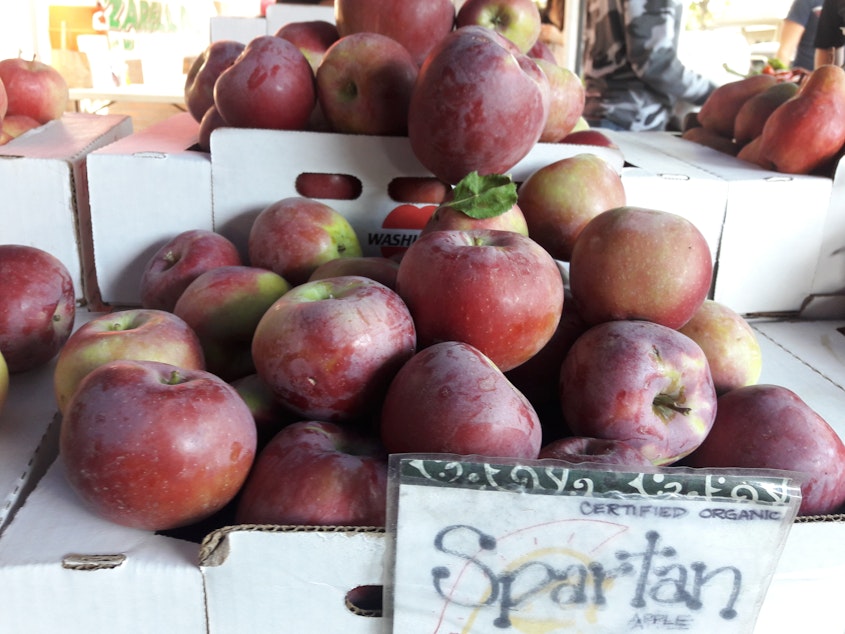It's hot toddy season. Did you know you can make them with apple peels?

You may have heard of "nose to tail" eating, a movement focused on consuming a whole animal to avoid waste. But if you're vegetarian, not to worry. There’s a similar effort using all parts of a vegetable or fruit.
Jill Lightner, author of Scraps, Peels and Stems, met me at the Capitol Hill farmer’s market to explain how.
We veered toward a stand with a large variety of apples and pears. Lightner likes to make pies and crisps with apples. But after she peels the fruit, she’s left with a pile of peels and cores. Instead of throwing it out, she turns them into a light cider drink, or "ciderkin."
“It turns out that going back to going back to the Colonial era in this country, there’s this thing called ciderkin that sometimes modern people call it apple tea,” she said. "You take those peels and those cores and you boil them up with some water. I throw in a knob of ginger to boost the flavor."
Use apples with deep, rich red skin, like Ruby Jon or Spartan, and you get a ciderkin with a pink tone, making it festive, said Lightner.
Lightner says ciderkin is versatile and less sugary than apple juice. Plus, you can create an adult drink with it. “It makes an amazing hot toddy if you add a splash of whisky to it—just a tip,” she said.
Lightner’s interest in scraps began about five years ago after reading about food waste. About 40 percent of uneaten food ends up in landfill. She became curious about her own food waste. So, for a month she and her husband weighed their food scraps from tea leaves to banana peels. She learned that her household wasn’t wasteful, but could do better.
“I got really interested in finding out how to get a second use out of things that were going in the compost bin,” Lightner said.
Some scraps became favorites. Like potato peels. “You can take the potato peels, toss them in olive oil, roast them in the oven on a sheet pan until they’re super crispy,” she said. “They are like homemade potato chips.”
Lightner likes to add coarse salt and malt vinegar to them. She says they make a great garnish for a creamy potato soup.
But not all experiments completely worked out. Lightner learned that deep frying asparagus peels gave the oil a strong asparagus flavor, which made it hard to reuse.
Before you start your own experiment with scraps, Lightner suggests taking a look at your compost bin to see what’s being thrown out. If there are lots of carrot peels, she says, maybe spend a little more time scrubbing the vegetables so you don’t need to peel them.
The idea is to play around with the ingredients. “You can really pat yourself on the back, feel like for sure you’re the next Top Chef for Seattle,” said Lightner. “It lets you feel fancy and creative while maybe saving a few bucks.”
Here's an example: Not sure what to do with all the green, unripe tomatoes in your yard? Make a pie, says Lightner.
Here's her family recipe:
Green Tomato Pie
Makes one (9-inch) pie
The flavor of this pie is remarkably like that of apple pie, and a cheerful way to say so long to your homegrown tomato harvest. This has been slightly modified to my taste from a recipe card belonging to my great-grandmother -- she used a lot more sugar, flour as a thickener, and cider vinegar; I prefer the flavor of the lemon, and the lighter texture of tapioca starch as a thickener. This is intended for unripe tomatoes, not green-when-ripe varietals like Green Zebra or Green Giant.
Two prepared (9-inch) pie crusts, divided use
6 large or 8 medium green tomatoes (1 ½ to 2 pounds)
1 cup plus 2 tablespoons granulated sugar
3 tablespoons tapioca starch
1/4 teaspoon freshly grated nutmeg
Zest from 1 medium lemon
1/2 teaspoon salt
1 egg plus 1 teaspoon water, for egg wash (optional)
Preheat oven to 425 degrees. Line a 9-inch pie dish with one of the crusts and refrigerate while you prepare the filling.
Stem, core and thinly slice the tomatoes, and place the slices in a large mixing bowl. Sprinkle the sugar, tapioca starch, nutmeg, lemon zest, and salt on top of the tomatoes and gently toss until the tomatoes are well coated. Pour the filling into the crust-lined pie dish, making sure to get all the liquid and any undissolved sugar out of the bowl.
Cut the second pie crust into strips and weave to make a lattice, or simply place it on top of the pie and cut several slits into it so steam can escape. Crimp the edges. Beat the egg and water together to make an egg wash, and use a pastry brush to dab it on the top crust and crimped edge. (There will be some leftover).
Bake on the bottom rack of the oven for 20 minutes. Reduce the temperature to 375 degrees, move the pie to the center rack, and bake for another 40 to 50 minutes, until the crust is deep golden brown and the filling is bubbling hot.




